The Liver Run

“One of the finest examples of police driving under pressure ever captured on video”
This commemorative page was launched on 8 May 2007 to mark the 20th anniversary.
What Was The Liver Run?
It was 8 May 1987. At the Cromwell Hospital in London a transplant patient’s body was chronically rejecting her recently replaced liver. A nationwide search located a suitable donor organ in Hull, and so began a life or death race against time to bring that organ to London. The plane that was flying it to London was delayed by fog. This meant that there was very little time to get the liver from the airport to the hospital. The ambulance service did not have a fast enough vehicle. The police helicopter was grounded. So it was down to two Metropolitan police Rover SD1s to make the last vital stage of the journey. The medical operation had already been started and surgeons were awaiting the arrival of the liver. If it was not there by 12:30 pm, the police were told to abort the run as it would be too late.
The police had just 34 minutes to cover 27 miles across London on this Friday afternoon. The journey they made was shown as a Police, Camera, Action! special in 1996.

What Was The Route?
After leaving Kingston upon Hull, the plane with the liver on board flew in to Stanstead Airport in Essex. An Essex police car then pulled up alongside the plane and transported the liver down the M11 from junction 8 to junction 7.
12 miles after it left the airport complex, the Essex police Ford Granada stopped on top of junction 7 ( A on map) and handed the liver over to 2 Metropolitan police Rover SD1 3500s.
The two Rovers (one as a back-up car) then sped Southbound into London. Their journey took them through East London, The City, Westminster and on to Kensington in West London. The final destination was the Cromwell Hospital ( B on map).
The run passed through: Blakehall Road, Green Man Roundabout, High Road (Leytonstone), The City, Embankment, Northumberland Avenue, Trafalgar Square, The Mall, Constitution Hill, Hyde Park Corner, South Carriage Road, The Cromwell Road.

Summary of The Run


At 11:54 the police are waiting on top of junction 7 of the M11 looking out for the Essex police Ford Granada to approach. As it does, they meet it at the top of the slip road. The video car blocks the road while officers move the box containing the liver from the Essex car to the Met car. These two images are taken at points A and B on the aerial view below.
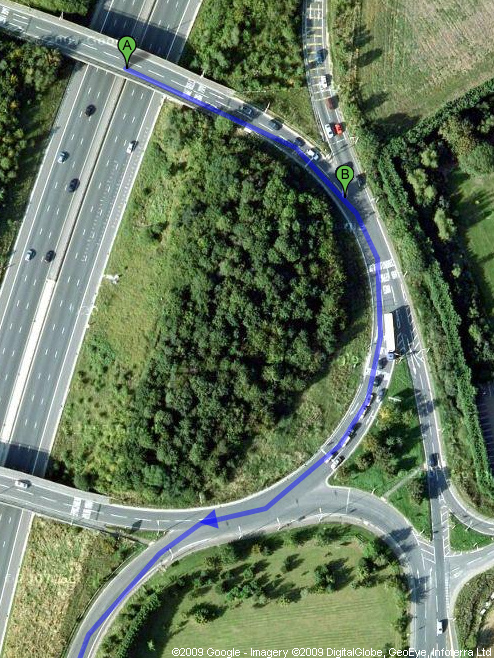
Aerial view of the M11 Junction 7

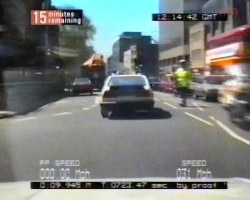
By 11:58 the cars have picked up speed on the M11 motorway and approaching 120 mph. By 12:14 they are making progress through the city streets. A number of police officers can be seen helping by keeping junctions clear. A motorcycle officer can be seen in the right-hand picture giving a wave. His bike is parked in the middle of the road.
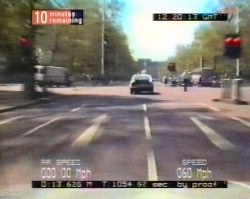

At 12:20 the cars are speeding down The Mall towards Buckingham Palace. You can see that they have just run a red traffic light at 60 mph, but officers on foot had stopped all approaching traffic. At ‘The Wedding Cake’ outside Buckingham Palace, the cars take to the wrong side of the road as the whole area has been kept clear for them.


At 12:25 the cars pull into the car park of the Cromwell Hospital. The police officers rush to grab the box with the liver in and pass it to a waiting porter. They later found out that because of their efforts the patient survived.
Who Was Involved?
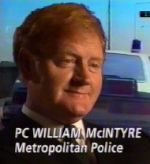
PC William (Bill) McIntyre was the driver of lead police car carrying liver
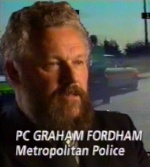
PC Graham Fordham was the co-driver of lead police car carrying liver

PC Les Crossland was the driver of back-up police car with the video camera

PC Steve McCabe was the co-driver of the back-up police car

Aliza Hillel was the patient awaiting the liver

Aliza Hillel meeting PC Graham Fordham (left) and PC Bill McIntyre for the first time in 1996 during the making of the Police Camera Action programme.

A promotional shot used to advertise the TV programme.
Why not use a helicopter?
The London HEMS air ambulance started in 1989, two years after the Liver Run! Also there was not enough time to organise a private helicopter.
The Metropolitan Police had a fleet of helicopters that could have been used, but they were all grounded. This was because just two days earlier, on 6 May 1987, Captain Mike Barry and his police crew were using one of the Met’s Bell 222A helicopters (G-META) when they encountered problems. Warning instruments told the pilot that one of the engines was not working properly. They immediately started to return to the air base at Lippitts Hill, about 4 minutes flying time away. During the journey a loud rumbling noise could be heard from the engine. As they crossed the boundary fence at Lippitts Hill, traveling at about 50 mph, an explosion ripped apart one of the two engines. The debris was showered over the surrounding land and also severely damaged the second engine and bodywork. The captain managed to make a controlled crash landing onto the helipad. No one was injured and the crew evacuated the aircraft while the captain stayed with it to shut down the systems and deal with a small fire. While this very dangerous episode was investigated, none of the Met’s aircraft were permitted to fly.

Trivia
- The liver was placed into the police car at 11:55:38 and was removed at 12:25:18, a total of 30 minutes.
- The Metropolitan police cars used were Rover SD1 3500s. The lead police vehicle was A738 UJD. The Rover 3500s were so popular with the Metropolitan Police that when they heard that Rover was to stop production, they stockpiled them so they could be used for a few more years.
- A porter was waiting at the hospital doors to receive the box with the liver in.
- The liver was carried in a box the size of an oversize picnic box.
- Humberside Airport (Hull) to Stanstead Airport (Essex) is 137 miles as the crow flies.
- The police in Hull faxed through the information about the liver run to the Met’s Motorway Control.
- The fastest speed the cars get up to is 120 mph on the M11.
- A new command complex at New Scotland Yard had just opened and this was a good test for it.
- Around 50 police officers were used to help transport the liver. These were mainly posted in advance to road junctions to stop the traffic as the liver run approached.
- When driving through The City area of London, two motorbikes from the City of London police helped escort the Metropolitan police cars. One of the motorbikes broke down on The Mall due to it being driven so hard.
- The Liver Run’s officers were based on the outskirts of London, and were not very familiar with the route they would be taking through central London.
- As this happened in the days before satellite navigation, the co-drivers in both cars relied on A-to-Z maps.
- The on-board ‘police pilot’ that is usually used to measure the speed of other motorists was used to look at the average speed of the run. The ‘police pilot’ was switched on at 12:02:39 and they arrived at the hospital at 12:25:07. It reads a distance of 16.690 miles and a time of 1347.95 seconds. The equates to an average speed of 44.6 miles per hour. This is not shown on the screen because the police officer did not press the ‘stop’ buttons due to being distracted by the importance of the organ transfer. The average does not include the first part of the run which was on a motorway at speeds between 60 and 120 mph.
- In July 2002, football legend and recovering alcoholic George Best underwent a liver transplant in the Cromwell Hospital. He was re-admitted on 3 October 2005 and spent his last weeks there in intensive care. He died at the hospital on 25 November 2005.
- The very Rover SD1 used in The Liver Run saw more police action in June 2010. Now in preservation, the Rover was carrying three serving police officers to a community event at RAF Northolt where it was to be displayed. A radio call for assistance from colleagues nearby was heard and the officers decided to use the still serviceable car to assist. One burglary suspect had been detained, and two outstanding suspects were apprehended by the officers in the Rover in Ruislip. The car is owned and maintained by serving officer David Butler.
Products
The Liver Run is not available on DVD or Video. The original recording belongs to the Metropolitan Police, London. The Liver Run episode was shown on ITV as part of the first season of Police, Camera, Action! programmes in 1996. It has not been released for the public to buy and belongs to Carlton UK Productions, who commissioned Optomen Television to produce it. A much shorter version of The Liver Run formed part of the video Police Stop! 5. However it was edited out when the programme was aired on television (Sky One). It is believed that Police Stop! 5 is not available on video. A very short clip of the run was used in a subsequent Police, Camera, Action! episode to highlight police vehicles being stuck in heavy traffic.
A Police Camera Action book has been produced which shows a number of pictures of The Liver Run alongside commentary text.
The Liver Re-run

When we interviewed Police, Camera, Action! host Alastair Stewart in 2006 about making a 20th anniversary programme about the run (for 2007), he said “It’s a very good idea”. It was suggested that preserved police vehicles that closely matched those used could be teamed up with the original police officers. The cars could then make the same journey (not using blue lights this time!) and be filmed at various stages. This idea did not come to fruition for the 20th anniversary, but did happen in 2014!
For The Love of Cars
Series 2, episode 2, of TV programme ‘For The Love Of Cars’ re-created the Liver Run while restoring a 1986 Rover SD1. They used one of the original cars, A536 UJD. Actor Philip Glenister teamed up with car restorer Ant Anstead on the run while being escorted by Met Police outriders.
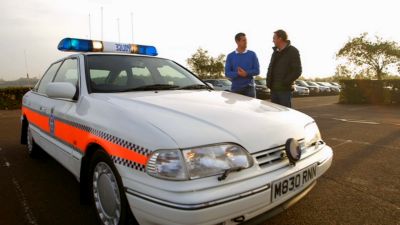
The first part of the journey from Stanstead to J7 of the M11 was done by Essex Police in a Ford Granada. Phil and Ant used a similar vehicle for this leg of the re-run. The preserved Ford Granada car was a little younger than the actual car used in the Liver Run and was actually a Derbyshire car rather than one from Essex.
Compare the Derbyshire car with the actual Essex car:

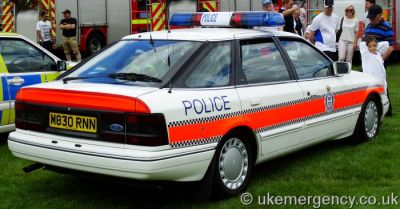

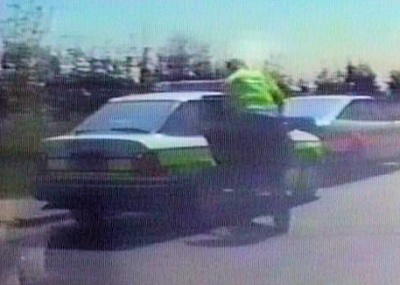
Back to the story…
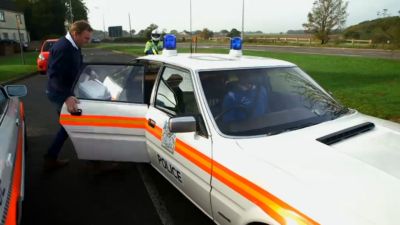
The exchange from Essex to the Met happens at Junction 7. The picnic box containing the liver is transferred to the back seats of the Rover. For the re-run, this exchange happened just off the motorway junction for safety.
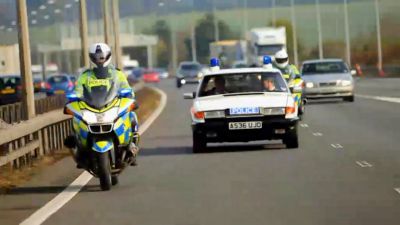
Once on the M11, the convoy got up to 120 mph in 1987, despite often being balked by heavy traffic. In the re-run the speed was kept to 70 mph, despite all vehicles showing blue flashing lights, as there wasn’t actually an emergency.
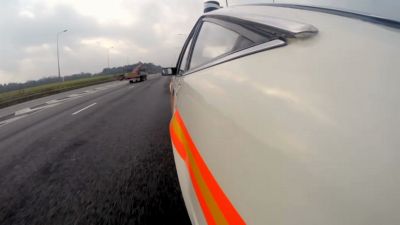
The light traffic on the M11 was in contrast to the busy Friday lunchtime traffic encountered on the original run.
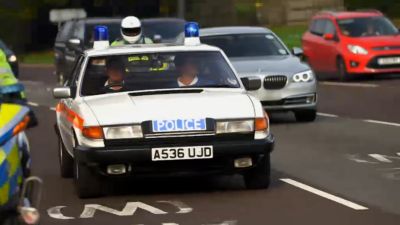

Making their way around a roundabout was easy with police outriders for help.

With Phil driving and Ant co-driving, their can’t help but enjoy the very special drive.

Making slow progress through central London allowed plenty of time for onlookers to do a double-take.

Even with blue lights showing, the convoy get stuck in heavy traffic. They didn’t intentionally pass any red traffic lights.

Turning into The Cromwell Hospital marks the last few metres of the run. No traffic is blocking the entrance here, unlike the actual day in 1987.
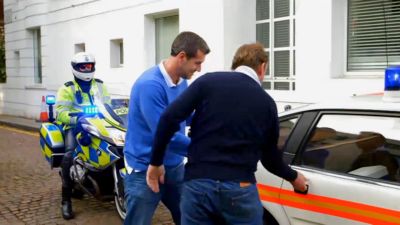
The final step is to grab the picnic box containing the liver and hand it over to the porter.
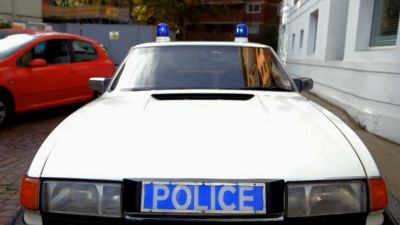
The car cools down after its historic re-run.

Philip Glenister and Ant Anstead outside the Cromwell Hospital. They muse about how long it took them to make the run compared to the incredible 30 minutes it took the Met back in May 1987.
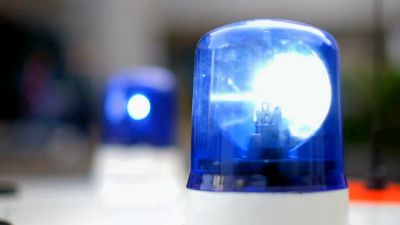
The twin blue rotating beacons on the roof of the Rover SD1 3500.
Video Footage
A copy of The Liver Run has previously been available on You Tube. It was removed for breaching copyright rules, but other copies may appear. We are not responsible for the contents of external websites.
Further Information
If you have any further information about The Liver Run, then please get in touch with us!
